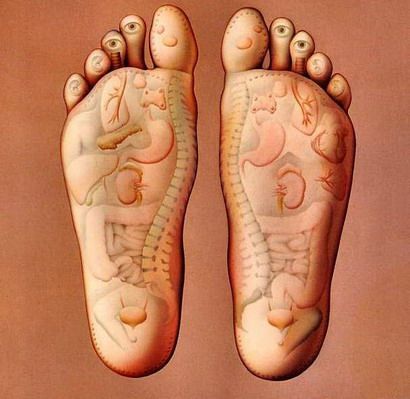
Who Doesn't Like a Good Foot Rub?
Even if you're ticklish, a good therapist can perform little luxuries on your feet. We recently discovered a foot-massage place in West L.A. ($28 an hour) and found out that there are a bunch of them in the San Gabriel Valley. Someday we'll go there with BeansTalk's CFO (who works there) and do a foot-massage tour.
For now, here's an article we wrote about Reflexology and how to give one, which we think of as purposeful massage. Father's Day is coming up and this might be a fun gift to offer your hublet, make a nice card and include a "gift certificate" for your services.
Reflexology, a non-invasive Holistic treatment, works to stimulate areas on the feet that correspond to different parts of the anatomy. In Reflexology, nerve endings on the feet correspond to organs and glands within the body. When pressure is applied to these nerve endings on the foot, it provides therapy to the areas of the body specific to the foot nerve endings.
Reflexology has a documented history going back 5,000 years. But the actual term “reflexology” was coined in the early 20th century in the U.S.
And reflexology feels great, even if while receiving the treatment, you’ may not be aware of which area of your body is benefiting from the therapist’s touch. It’s a great gift to give, once you learn just how to do it. Start by getting a professional reflexology treatment so you can experience it and look closely at a reflexology foot chart (a sample of one is shown in an image here). Then, you’ll no doubt find a willing subject.
Ideally, the person being massaged should be seated in a recliner or an arm chair with an ottoman. The reflexologist (in this case, you) can sit on a small stool in from of their feet.
You’ll Need:
- basin of hot water (optional)
towels (optional)
massage oil (optional)
Give the Gift of a Reflexology Massage
Step 1:
Get a basin (professional therapists often use wood basins with a large plastic bag as a liner) and fill it with water as hot as your “client” can stand it. Some places put in a tea bag, others use fresh flowers, or bath salts. Have the person soak their feet for about five to 10 mins. Cover their legs with a bath towel.
Step 2:
 Gently dry feet with a soft towel.
Gently dry feet with a soft towel.
Step 3:
Place a feet on your thigh, work on the feet on the ottoman or hold the foot up.
Step 4:
 Start by taking your thumb and moving in a small circular pattern around each area of the sole. Press firmly, with your hands and fingers, using a pulsing, on/off pressure. Oil/lotion is optional.
Start by taking your thumb and moving in a small circular pattern around each area of the sole. Press firmly, with your hands and fingers, using a pulsing, on/off pressure. Oil/lotion is optional.
Step 5:
Start just below the balls of the feet, which corresponds with the solar plexus.
Step 6:
 Move to an other area by inching your thumb. Continue to press firmly, using a pulsing on/off pressure, while making a circular pattern.
Move to an other area by inching your thumb. Continue to press firmly, using a pulsing on/off pressure, while making a circular pattern.
Step 7:
Proceed slowly and patiently, experimenting to find a comfortable pressure. Ask if the pressure is ok. Painful places may indicate an imbalance or ailment in the related organ or body system. (For example, rub under the little toe at the “root,” if the client experiences a sharp pain, that directly correlates to their left shoulder.
Step 8:
Concentrate on tender areas and trouble spots, building pressure as you go along.
Step 9:
Spend five to 10 minutes on each foot, initially, building to more time as you become more familiar with the areas of the feet that are corresponding to various parts of the body (this will come from a greater understanding of the foot reflexology chart).
Step 10:
Tell clients to wear comfortable shoes, drink water or decaffeinated drinks and to avoid alcohol. Experts say this promotes the detoxification process and help the body to eliminate the toxins that have been released.
Tips
- Those who poo-poo alternative treatments may be surprised to know that a study published in the American Journal of Obstetrics and Gynecology found that women with PMS who underwent 30-minute reflexology treatments for two months experienced a 46-percent reduction in symptoms, and maintained the benefits for two months following treatment.
- You can also give a very rudimentary reflexology treatment by using the technique on feet without the preliminary foot bath and lotion/oil.
- You can also do self-reflexology, using the technique on yourself.
- Even though an area of pain is associated with distress in another part of the body, you should take care not to injure, the goal of reflexology is one of treatment and relaxation.